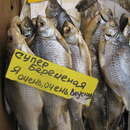Diagnostic Description
provided by Fishbase
Diagnosed from its congeners in Black Sea basin by having the combination of the following characters: laterally compressed body; 39-41 + 2-3 scales along lateral line; dorsal and anal fins usually with 10½ branched rays; mouth inferior; iris from silvery to yellow; pectoral, pelvic and anal fins grey with dark margins; and breeding males with scattered tubercles on head and a tubercle on each flank scale (Ref. 59043).
Biology
provided by Fishbase
A semi-anadromous species. Occurs mostly in shallow brackish coastal waters. While at sea, adults are most abundant at depth of 2.5-4.0 m and salinity of 2-4 ppt. Enters freshwater of estuaries, lagoons and lower reaches of large rivers to spawn. Commences movement to coast in August and to rivers in September, with a peak in October. Stops migration by end of November and overwinters in main river or estuaries. Continues spawning migration with breaking up of ice in March (Dniepr). Breeds in April-May. Adults migrate back to estuaries to forage immediately after spawning. Juveniles move to estuaries during first summer in August. Reported decline was due to blocking of almost all spawning rivers and decline of brackish areas in Black Sea basin (Ref. 59043).

